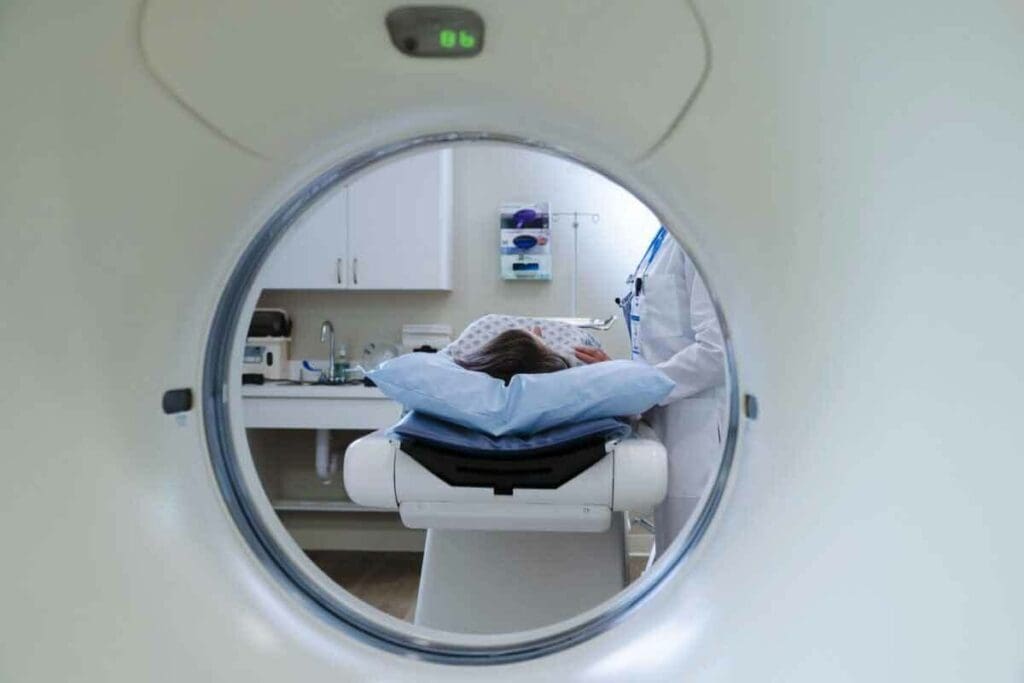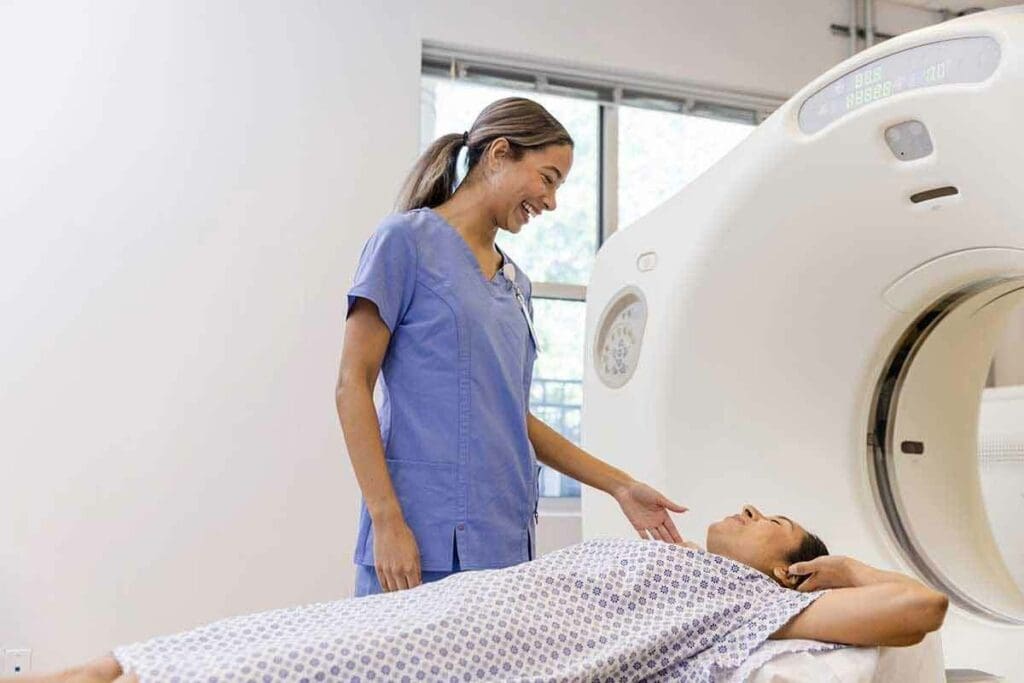Last Updated on November 27, 2025 by Bilal Hasdemir

When we talk about diagnosing head, brain, and cancer issues, MRI and CT scans are key. At Liv Hospital, we know picking the right imaging method is vital. It helps get accurate diagnoses and effective treatments.
MRI stands for magnetic resonance imaging. It uses strong magnets and radio waves to show detailed images of soft tissues. Unlike CT scans, which use X-rays, MRI offers a unique view of the body’s inner workings. Understanding which is better MRI or CT scan helps determine the best choice for specific health needs.
Key Takeaways
- MRI and CT scans are both advanced imaging techniques with different strengths.
- MRI generates highly detailed images of soft tissues using strong magnets and radio waves.
- The choice between MRI and CT scans depends on the specific condition being diagnosed.
- Liv Hospital uses a patient-centered approach to determine the best imaging technique for each clinical need.
- Understanding the differences between MRI and CT scans is key for accurate diagnosis and effective treatment.
Understanding MRI and CT Scan Technology

The world of medical imaging is led by MRI and CT scans. Each has its own strengths and uses. To know which is better for certain health issues, we must understand how they work.
How MRI Technology Works
MRI, or Magnetic Resonance Imaging, uses strong magnetic fields and radio waves. It creates detailed images of the body’s inside. MRI technology is great at showing soft tissues. This makes it very useful for checking the brain, spinal cord, and other soft tissues.
During an MRI, the patient is in a big magnet. Radio waves disturb the magnetic field. When the field returns, signals are sent out. These signals help make detailed images.
How CT Scan Technology Works
CT scans, or Computed Tomography scans, use X-rays to make images of the body. CT scan technology is good for seeing bones, lungs, and other internal parts. It’s also quicker than MRI, making it perfect for urgent cases.
A CT scan has an X-ray machine that moves around the body. It takes pictures from different angles. Then, these images are put together to make detailed cross-sections.
Key Technological Differences
The main difference between MRI and CT scans is their imaging methods. MRI uses magnetic fields and radio waves. CT scans use X-rays. This affects their uses and how well they work for different health problems.
- MRI is better for soft tissue images.
- CT scans are better for bone and lung images.
- MRI doesn’t use ionizing radiation, making it safer for some patients.
Comparing Image Quality and Detail

It’s important to know how MRI and CT scans differ in image quality. This helps decide which one is best for a diagnosis. The choice depends on the type of tissue and how much detail is needed.
Soft Tissue Visualization
MRI scans are great at showing soft tissues. They create detailed images that doctors use to spot problems in the body. This makes MRI very useful for brain and neurological issues.
MRI’s superiority in soft tissue imaging comes from its ability to see different soft tissues. It shows tendons, ligaments, and organs clearly. This is key for accurate diagnosis and treatment.
Bone Structure Imaging
CT scans are better for looking at bones. They give detailed images of bones and are used in emergencies. This is because they can quickly show bone fractures or injuries.
CT scans use X-rays to make detailed images of the body, including bones. They help diagnose osteoporosis, bone fractures, and some bone cancers.
Contrast Enhancement Capabilities
Both MRI and CT scans can use contrast agents to make images clearer. But, how they use these agents is different.
| Imaging Modality | Soft Tissue Visualization | Bone Structure Imaging | Contrast Enhancement |
| MRI | Excellent | Limited | Gadolinium-based contrast |
| CT Scan | Good | Excellent | Iodine-based contrast |
In conclusion, the choice between MRI and CT scans depends on what you need to see. MRI is best for soft tissues, while CT scans are better for bones. Knowing these differences helps doctors choose the right imaging for patients.
Which Is Better: MRI or CT Scan for Brain Imaging?
Choosing between MRI and CT scans for brain imaging depends on the condition being looked at. We’ll look at MRI’s benefits for neurological issues and when to pick one over the other.
MRI Advantages for Neurological Conditions
MRI is great for neurological conditions because it spots tiny changes in brain tissue well. MRI is better than CT scans for finding tumors, multiple sclerosis, and blood vessel problems. For example, MRI can spot demyelination in multiple sclerosis early, helping with treatment plans.
Some key MRI benefits for neurological issues include:
- It shows soft tissues clearly
- It finds lesions and problems CT scans miss
- It shows brain blood vessels well
For brain tumors, MRI gives detailed images. These help doctors plan treatments like surgery, radiation, or chemo. You can learn more about this at this link.
Clinical Scenarios Determining the Choice
The choice between MRI and CT scans depends on the situation. In emergencies like stroke or trauma, CT scans are faster and more available. But for long-term conditions or detailed soft tissue images, MRI is better.
Here are some cases where MRI is preferred:
- Diagnosing and tracking multiple sclerosis
- Checking brain tumors and metastases
- Looking at blood vessel issues like aneurysms or malformations
In summary, MRI and CT scans both have roles in brain imaging. The right choice depends on the specific situation and what’s needed for diagnosis and treatment.
Head Imaging: CT vs MRI Effectiveness
CT scans and MRI are key tools in head imaging. They are used for different reasons. The choice depends on the situation, the patient’s health, and what doctors need to know.
Trauma and Emergency Situations
In emergencies, CT scans are often the first choice. They are fast and give important info quickly. CT scans are great for finding bleeding, fractures, and other urgent injuries.
We count on CT scans in emergencies. They give a quick and accurate look at head injuries.
Vascular Abnormalities Detection
MRI is better at finding problems with blood vessels, like aneurysms. It shows the brain’s blood vessels in detail. This makes MRI key for diagnosing blood vessel issues.
MRI doesn’t use harmful radiation. This is good for patients who need to be watched closely.
Sinus and Skull Base Evaluation
MRI is best for looking at sinuses and the skull base. It shows soft tissues clearly. This is important for diagnosing and treating problems in these areas.
Cancer Detection and Monitoring: MRI vs CT Scan
Choosing between MRI and CT scans is key for finding and tracking cancer. Each has its own strengths for different situations.
Tumor Identification Capabilities
MRI is great at showing soft tissues, which helps find tumors in places like the prostate, breast, and liver. It’s better than CT scans for these areas.
MRI’s advantages in tumor identification include:
- High-resolution images of soft tissues
- Better detection of tumors in complex anatomical areas
- Enhanced visualization of tumor boundaries
Staging and Treatment Planning
CT scans are better for the first step of cancer staging. They can quickly look at the whole body and find cancer in places like the lungs and liver. This is important for planning treatment.
| Imaging Modality | Cancer Staging | Treatment Planning |
| MRI | Detailed soft tissue imaging | Precise tumor delineation for surgery or radiation |
| CT Scan | Comprehensive whole-body imaging | Assessment of tumor response to treatment |
Follow-up and Recurrence Detection
Both MRI and CT scans are used for follow-up and finding cancer again. MRI is best for the brain and spine, while CT scans are used elsewhere.
For example, in brain tumors, MRI’s sensitivity to soft tissue changes is perfect for follow-up.
In summary, the choice between MRI and CT scan depends on the cancer type, location, and stage. Knowing each modality’s strengths helps doctors make the best decisions for patients.
Safety Considerations and Contraindications
When it comes to diagnostic imaging, safety is key. Both MRI and CT scans have their own safety profiles. Healthcare providers consider these when choosing the best diagnostic approach for patients.
Radiation Exposure Risks
One major safety concern is radiation exposure. CT scans use X-rays, which involve a small dose of ionizing radiation. This dose is carefully controlled and minimized. Yet, it’s a factor to consider, mainly for patients needing repeated scans or being sensitive to radiation.
MRI, on the other hand, uses magnetic fields and radio waves, eliminating radiation exposure. Experts at Liv Hospital say MRI is safer for certain patients.
The risks from CT scans’ radiation are generally low but not zero. We must balance these risks against the scan’s benefits. For patients needing many scans, the total radiation exposure is a big concern.
Metal Implants and Device Compatibility
Another key safety consideration is metal implants or devices. MRI scans’ strong magnetic fields can interact with certain metal implants. Patients need to tell their healthcare providers about any metal implants before an MRI. CT scans do not have this contraindication, making them safer for patients with certain metal implants.
- Patients with pacemakers or other implanted electronic devices may need to avoid MRI scans.
- Some metal implants may not be compatible with MRI, while others may be safe under specific conditions.
- CT scans are generally safer for patients with metal implants, but it’s important to disclose any implants to your healthcare provider.
Claustrophobia and Patient Comfort
Patient comfort is also a big factor. MRI scans often require patients to be enclosed in a large magnet, which can trigger claustrophobia. Open MRI machines are available for those with severe claustrophobia, but they’re not as common as traditional MRI machines. CT scans are quicker and don’t require the same level of enclosure, making them more comfortable for some patients.
“The choice between MRI and CT scans must be tailored to the individual patient’s needs, taking into account not only the diagnostic requirements but also the patient’s safety and comfort.”
Notes a radiology specialist.
In conclusion, when choosing between MRI and CT scans, safety is key. We must consider radiation exposure, metal implant compatibility, and patient comfort. By weighing these factors, healthcare providers can make informed decisions that balance diagnostic needs with patient safety and well-being.
Practical Factors: Time, Cost, and Accessibility
When choosing between MRI and CT scans, time, cost, and where you can get them matter a lot. These factors can really affect your choice.
Procedure Duration Comparison
The time it takes for a scan is very important. CT scans are quicker, finishing in just a few minutes. On the other hand, MRI scans take longer, from 20 to 90 minutes.
This time difference affects how many patients a place can see. For urgent cases or those who can’t stay long, CT scans are better.
Cost Differences and Insurance Coverage
Cost is a big deal when picking between MRI and CT scans. CT scans cost less upfront and for follow-up care. MRI scans are pricier.
Insurance plans also differ. It’s key to check your coverage before getting a scan.
| Imaging Modality | Average Cost Range | Typical Insurance Coverage |
| CT Scan | $200 – $1,000 | Often covered with copay |
| MRI | $500 – $3,000 | May require pre-approval, higher copay |
Availability in Different Healthcare Settings
Where you can get MRI and CT scans varies a lot. CT scanners are found more often in emergency rooms and smaller hospitals. They’re cheaper and scan faster.
MRI machines are mostly in big hospitals and special imaging centers. They’re more expensive and need more space, so they’re less common.
When deciding on MRI or CT scans, think about these practical points. Talk to your doctor to choose wisely.
Special Patient Populations: Children, Pregnant Women, and Elderly
Choosing between MRI and CT scans is critical for children, pregnant women, and the elderly. Each group has unique needs and risks. We must carefully decide which imaging method is best for them.
Pediatric Imaging Considerations
MRI is often preferred for kids because it’s safer. It doesn’t use radiation, which is a big plus. CT scans, with their radiation, pose a risk to young patients.
At times, MRI might need sedation to keep kids calm. But, when done right, it’s safe. MRI helps diagnose and track conditions in children, making it a good choice.
Pregnancy Safety Protocols
For pregnant women, safety is key. MRI is generally safer than CT scans because it doesn’t use harmful radiation. Yet, MRI use in early pregnancy is carefully thought out.
If a CT scan is needed, we try to lower radiation to the fetus. This might mean using other imaging methods or adjusting the CT scan settings.
In summary, picking MRI or CT scans for special patients requires careful thought. We aim to choose the safest and most effective imaging for each group.
Conclusion: Making the Right Choice Between MRI and CT Scan
Choosing between MRI and CT scans depends on the medical condition and patient needs. Both offer important diagnostic info. But, the right choice varies based on the condition, safety, and practical factors like time and cost.
The debate on MRI vs CT scan is ongoing. MRI is better for soft tissue and neurological issues. CT scans are used in emergencies and for bone imaging. For cancer, the choice between MRI and CT scan depends on the cancer type and situation.
Knowing the strengths and limits of each modality helps us make better decisions for patient care. Whether it’s MRI or CT scan, our goal is accurate diagnoses and effective treatments. We must consider the benefits and risks to choose the best option for each patient.
FAQ
Is a MRI or CT scan better for diagnosing brain conditions?
MRI is usually better for brain conditions. It can spot small changes in brain tissue. It also gives detailed images of soft tissues.
Which is better: CT scan or MRI for head imaging?
The choice between CT scan and MRI depends on the condition. CT scans are good for trauma and emergencies. MRI is better for vascular issues and the sinuses.
Is CT scan better or MRI for cancer detection?
Both MRI and CT scans help find cancer. MRI is great for seeing tumors and how big they are. CT scans are used for the first check and to see how treatment is working.
What are the safety considerations when choosing between MRI and CT scans?
CT scans use radiation, but the dose is controlled. MRI doesn’t use radiation but might not work for people with metal implants.
How do practical factors such as time, cost, and accessibility influence the choice between MRI and CT scans?
CT scans are quicker and cheaper, making them more common. But MRI gives more detailed images, even if it takes longer and costs more.
What is the difference between MRI and CT scan of the brain?
MRI shows soft tissues well, perfect for brain conditions. CT scans are better for bones and finding acute injuries.
Is MRI better than CT scan for detecting vascular abnormalities?
Yes, MRI is better for blood vessel issues in the brain. It’s a key tool for diagnosing vascular problems.
Can MRI or CT scan be used for cancer staging and treatment planning?
Both MRI and CT scans help with cancer planning. CT scans are often first used. MRI gives more detailed images for treatment planning.
Are there any contraindications for MRI or CT scans?
Yes, MRI might not work for people with metal implants. CT scans use radiation, which is a concern for pregnant women and kids.
How do MRI and CT scans differ in terms of image quality and detail?
MRI excels in capturing soft tissue images, like brain tissue. CT scans are better for bones and finding acute injuries.
References
- Saat, A., et al. (2023). Comparative Efficacy of MRI and CT in Traumatic Brain Injury: Systematic Review. PMC. m https://pmc.ncbi.nlm.nih.gov/articles/PMC11579544/
- Sarkis, L., et al. (2021). MRI versus CT in the detection of brain lesions in infective endocarditis (IE) patients. Neuroradiology. https://link.springer.com/article/10.1007/s00234-021-02810-y






